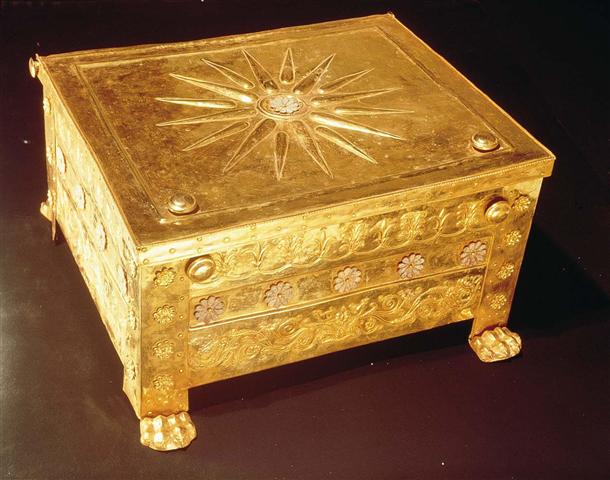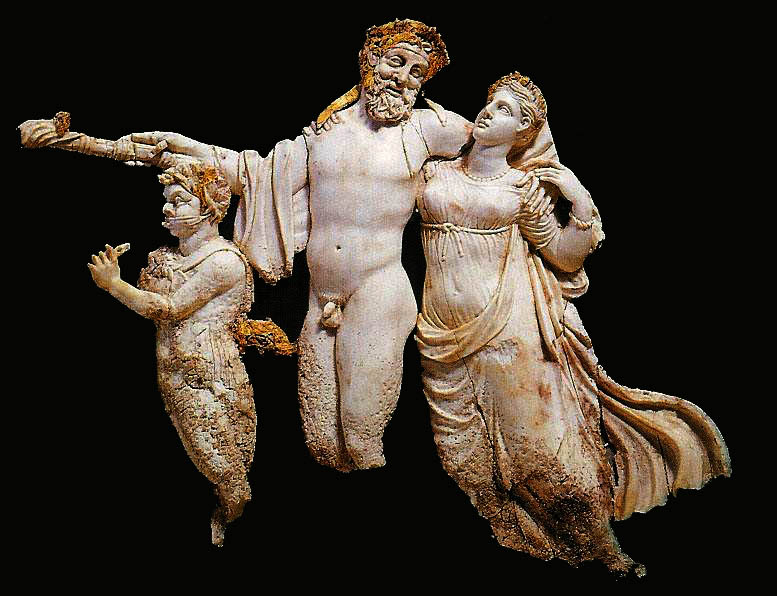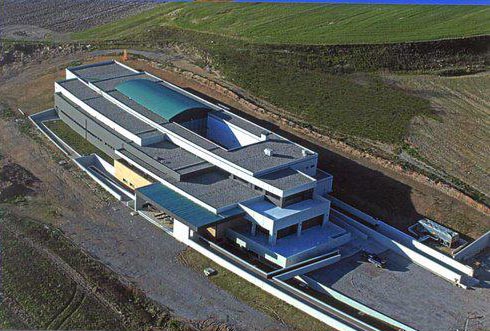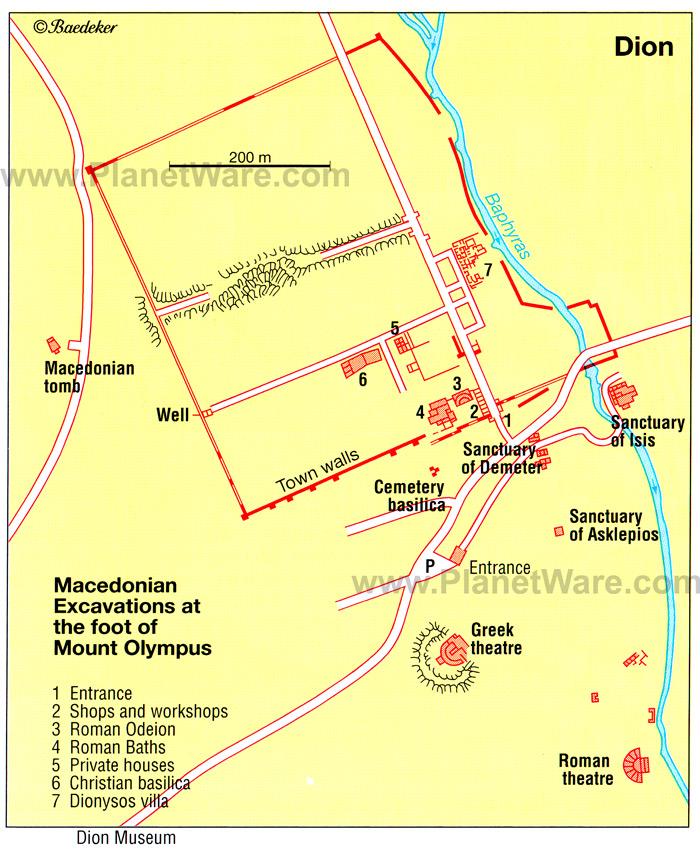
The Stones of Greece
Makedonia
Google-Map
Aigai-Vergina,
the Royal Palace***
4th cent BC

Royal Makedonian Palace (278-240 BC) Greek Landscapes
In approximately 650 BC, the Argeads, an ancient Greek royal house led by Perdiccas I, fled from Argos and established their capital at Aegae, thereby also establishing the Kingdom of Macedon.The word Aigae is the plural of the ancient Greek word Aiga (Αίγα) which means goat. The capital city of the Mαcedon kings was called so after Perdikas I, had a dream in which he was asked to build the capital city of his kingdom where goats led him.
In the 5th century BC, King Archelaus I moved the Macedonian capital north to Pella on the central Macedonian plain. Aegae remained an important ceremonial center but lost a festival in honor of Zeus to Dion. Aegae continued to flourish into the 3rd century BC until it was destroyed in the 1st century BC.
The Palace and a Theatre are the two important monuments dated to the 4th century B.C. The palace is organized around a large, central peristyle court and comprises a circular shrine (Tholos) dedicated to Herakles Patroos, and luxurious banquet halls for the king and his officers. One of these rooms includes a fine mosaic floor.
The Aigai acropolis is located on the hill south of the palace. The
famous Royal Tomb pf Philip II was found 1.5 km to the
northwest.
HMCT
Odysseus
Aigai-Vergina,
Royal Tombs***
4th-1st cent BC

Eurythiki's Tomb IV, Panoramio
The Greek archaeologist Manolis Andronikos became convinced that a hill called the Great Tumulus (Greek: Μεγάλη Τούμπα) concealed the tombs of the Macedonian kings. In 1977, Andronikos undertook a six-week dig at the Great Tumulus and found four buried chambers, which he identified as hitherto undisturbed tombs. Three more were found in 1980. Excavations continued through the 1980s and 1990s.
Andronikos conjectured that these were the burial sites of the kings of Macedon, including the tomb of Philip II, father of Alexander the Great (Tomb II). Andronikos maintained that another tomb (Tomb III) was of Alexander IV of Macedon, son of Alexander the Great and Roxana
This view is challenged by some archaeologists. Studies by Eugene N. Borza, utilizing the construction of ceilings of Tomb II, the incorporation of a weight measurement system introduced by Alexander the Great on golden objects in the tomb, Asian themes on the tomb's friezes, and the discovery of a scepter similar to that found on coins minted under Alexander's reign, as well as studies which utilized anthropological data, suggest that this tomb belongs to Alexander's half-brother Philip III Arrhidaeus and his wife, Adea Eurydice. Instead, according to Borza, Tomb I, also known as the Tomb of Persephone may have contained the remains of Phillip II and his family. If this theory is true, then the golden weaponry and royal objects found in Tomb II may have belonged to Alexander the Great.
On the other hand, a 2010 research supports that Tomb II cannot
belong to Philip III Arrhidaus and his wife. This research, based on
detailed study of the skeletons, sustains the facial asymmetry caused
by a possible trauma of the cranium of the male, an evidence that is
consistent with the history of Philip II.
Medical-forensic
discussion of identity of the buried people
In 1978 another burial site (Tomb III) was discovered near the tomb of Philip, which belongs to Alexander IV of Macedon son of Alexander the Great. It was slightly smaller than the previous and was also unlooted. It was arranged in two parts, but only the main room contained a cremated body this time. On a stone pedestal was found a silver hydria which contained the bones and on it a golden oak wreath. There were also utensils and weaponry. A narrow frieze with a chariot race decorated the walls of the tomb.

Hades' rape of Persephone (the woman in his arms), detail
The other two tombs were found to have been looted. Tomb I or
the Tomb of Persephone was discovered in 1977 and although it
contained no valuable things, on its walls was found a marvellous
wall painting showing the abduction of Persephone by Pluto. Tomb
IV, discovered in 1980, is heavily damaged and may have contained
valuable treasures while it had an impressive entrance with four
Doric columns. It was built in the 4th century BC and the
archaeologists believe that the tomb belonged to Antigonus II
Gonatas.
Wikipedia
Aigai-Vergina,
Great Tumulus and Museum****
4th-1st cent BC

Philips II's Myrtle Wreath

Gold Larnax which contained Philip II's Ashes
The museum, which was inaugurated in 1993, was built in a way to protect the tombs, exhibit the artifacts and show the tumulus as it was before the excavations. Inside the museum there are four tombs and one small temple, the heroon built as the temple for the great tomb of Philip II of Macedon. The two most important graves were not looted and contained the main treasures of the museum.
Tomb II of Philip II, the father of Alexander was discovered in 1977 and contained two rooms. The main room included a marble sarcophagus, and in it was the larnax made of 24 carat gold and weighing 11 kilograms. Inside the golden larnax the bones of the dead were found and a golden wreath of 313 oak leaves and 68 acorns, weighing 717 grams. In the room were also found the golden and ivory panoply of the dead, the richly-carved burial bed on which he was laid and later burned and silver utensils for the funeral feast.

Golden Wreath of the Queen
In the antechamber, there was another sarcophagus with a smaller
golden larnax containing the bones of a woman wrapped in a
golden-purple cloth with a golden diadem decorated with flowers and
enamel. There was one more bed, partially destroyed by fire, and on
it a golden wreath representing leaves and flowers of myrtle. Above
the Doric order entrance of the tomb there is a wall painting
measuring 5.60 metres which represents a hunting scene.
Wikipedia
Other archeological treasures and curiosities found at Aigai and now housed at the Museum (formerly at the Archeological Mseum of Thessaloniki).

Dionysos with Eros and Aphrodite,
Ivory carving, traces of
gilding from Tomb IV, origin Central Asia(?), 2nd cent BC
|
|
|
|
Three of 26 life-size clay heads found in one of the Aigai tombs, 2nd cent. BC
Pella,
Royal Macedonian Capital***
399-168 BC

The city was built on the island of Phacos, a promontory which dominated the wetlands which encircle Pella to the south, and a lake which opened to the sea in Hellenistic times.
The city wall mentioned by Livy is only partly known. It consists of a rampart of crude bricks raised on a stone foundation; some of which has been located North of the palace, and some in the South next to the lake. Inside the ramparts, three hills occupy the North, and the palace is situated on a place of honour on the central hill. Partly searched, it occupied a considerable area of perhaps 60,000 square metres. The plan is still not well known, but has been related to that of the city plan.
The Pella palace consisted of several — possibly seven — large architectural groupings juxtaposed in two rows, each including a series of rooms arranged around a central square courtyard, generally with porticos. Archaeologists have thus far identified a palaestra and baths. The south facade of the palace, towards the city, consisted of one large (at least 153 metres long) portico, constructed on a two metres high foundation. The relationship between the four principal complexes is defined by an interruption in the portico occuupied by a triple propylaeum, 15 m high, which gave the palace an imposing monumental air when seen from the city below.
Dating of the palace has posed some problems: the large buildings could date the reign of Philip II, but other buildings appear to be earlier. The baths date from the reign of Cassander.
The size of the complex indicates that, unlike the palace at Vergina, this was not only a royal residence or a grandiose monument but also a place of government which was required to accommodate a portion of the administrative apparatus of the kingdom.
The city was founded in 399 BC by King Archelaus (413–399 BC) as
the capital of his kingdom, replacing the older palace-city of Aigai.
After this, it was the seat of the king Philip II and of Alexander,
his son. In 168 BC, it was sacked by the Romans, and its treasury
transported to Rome. Later, the city was destroyed by an earthquake
and eventually was rebuilt over its ruins. By 180 AD, Lucian of
Samosata could describe it in passing as "now insignificant,
with very few inhabitants".
Wikipedia

Dionysos riding a Panther, Floor mosaic from the main palace, Wikipedia
Pella, New
Tombs
3rd-2nd cent BC
In February 2006, a farmer accidentally uncovered the largest tomb ever found in Greece. The names of the noble ancient Macedonian family are still on inscriptions and painted sculptures and walls have survived. The tomb dates to the 2nd or 3rd century BC, following the rule of Alexander the Great
2012 - Since then some 50 more graves have been found in this area some dating from 650-500 BC.
Pella, New Archeological Museum***

Opened 2010, the museum will house all artifacts from Pella now in Thessaloniki
Archeological Museum Thessaloniki****
6 Manoli Andronikou, Thessalonika 54621, Tel: +30 231 083 0538
Notable exhibits:
Derveni krater
The Statue of Arpocrates (end of 2nd c. B.C.)
The
Head of Serapis (2nd c. B.C.)
Gold larnax believed to contain the
remains of King Philippos II
Bronze helmet and gold mask (cemetery
of Sindos, end of 6th c. B.C.)
Marble door (Macedonia tomb of Agia
Paraskevi)
Copy of "Unveiling" Aphrodite (421/420
B.C.)
Gold medals (225–250 B.C.)
Inlaid floors (mosaic)
Gold
shield (from the royal tombs of Vergina)
Gold diadems, gold disks
and gold Medusa heads (350-325 B.C.)
For a preview see: Latsis' Museum Catalog
Derveni
Necropole
4th cent BC
A collection of tombs from the classic and hellenistic periods were found in the area, many of them containing important artifacts.

Derveni crater found in a tomb at the Derveni necropolis
The Derveni krater is a volute krater, the most elaborate of its type, discovered in 1962 in a tomb at Derveni, not far from Thessaloniki, and displayed at the Archaeological Museum of Thessaloniki. Weighing 40 kg, it is made of bronze.
The exact date and place of making are disputed. Based on the dialectal forms used in the inscription, some commentators think it was fabricated in Thessaly at the time of the revolt of the Aleuadae, around 350 BC. Others date it between 330 and 320 BC and credit it to bronzesmiths of the royal court of Philip II of Macedon.

Also found at Derveni was the oldest Greek papyros
It is a philosophical treatise that is an allegorical commentary on an Orphic poem, a theogony concerning the birth of the gods, produced in the circle of the philosopher Anaxagoras in the second half of the 5th century BC, making it "the most important new piece of evidence about Greek philosophy and religion to come to light since the Renaissance" (Janko 2005). It dates to around 340 BC, during the reign of Philip II of Macedon, making it Europe's oldest surviving manuscript. It was finally published in 2006.
Dion
Archeological Site***
5th cent BC - 5th cent AD

The site under Mt. Olympos, photo Ava Babili, wooze.gr

Map of the archeological area, from Planetware
Dion stands in the northern foothills of Mount Olympus, and exercises complete control over the narrow defile leading from Macedonia to Thessaly. Formerly a distance of only 7 stades from the shores of the Thermaic Gulf, it was the most important sacred city of the Macedonians. Here it was that Archelaos I, at the end of the 5th century B.C., first held brilliant festivals at which sacrifices were offered to Olympian Zeus and the Pierian Muses, and introduced theatrical and gymnastic competitions - the "Olympia ta en Dion" - which were still celebrated about 100 B.C.
The first Roman colonists (colony) possibly settled here in 43 B.C.,
perhaps as a result of the activities of Brutus; the mass
transportation of Italians to the city and the foundation of the
colonia was the work of Augustus, however, immediately after his
victory in the battle of Actium (31 B.C.). Despite the fact that
Latin was the official language, the majority of the inscriptions are
in Greek, attesting both to the predominance of the local element and
to the swift hellenisation of the newcomers.
HMCT
Odyseus
Kavala,
Mehmed Ali Pasha Imaret**
1808-1821 AD

The meticulously restored Imaret of Mehmet Ali Pasha (19th cent AD Ottoman)
Originally built in 1817 by Mohamed Ali Pasha, the founder of the Egyptian dynasty, the Imaret consisted of a series of inter-related buildings, including schools, a Mosque, a Hamam, administrative offices and the Imaret itself (free public soup kitchen). It quickly became a recognized center of learning throughout the Balkans, during the last phase of the Ottoman Empire. One of the rare renains of Ottoman Architecture in Greece.
Mohamed Ali Pasha, the founder of the Egyptian dynasty of the Fouats, donated the Imaret to Kavala, the city of his birth. The Imaret is now a luxury hotel, a member of the exclusive Historic Hotels of Europe.
Petralona Cave and Museum
A skull supposedly from 70 000 BC was found here. It is more likely is from 300 000 to 200 000 BC. Controversy surrounds the interpretation of this cranium, and it has been variously classified as Homo erectus, as a classic Neanderthal (Homo neanderthalensis), and as an early representative of Homo sapiens sapiens in a generalized sense (Day 1986: 91-95). The consensus among paleoanthropologists today is that the cranium belongs to an archaic hominid distinguished from Homo erectus and from both the classic Neanderthals and anatomically modern humans (Day 1986: 95; Stringer, Howell, and Melenitis 1979).... Whatever the final classification may be, the cranium has been provisionally dated to ca. 200-400 kyr (Day 1986: 94 Hennig et al. 1981, 1982; Wintle and Jacobs 1982), and it is thus possible that the Petralona hominid represents the lineage responsible for the Thessalian Lower Paleolithic sites. - The cave has been a rich source of paleolithic species, is however only marginally interesting to the general public. The scull is kept at the University of Thessaloniki.
A sad Greek Story
The Petralona Cave and Anthropological Museum was privately owned by
the "Anthropological Association of Greece", founded and
first presided over by Prof. Aris Nickos Poulianos. later by his son,
which has held the concession for the exploration of the cave since
the beginning of the 1960s. Poulianos, in his youth a member of ELAS
and the DSE from Ikaria, later with a doctorate in Anthropology from
Moscow, named the hominid scull Archanthropus europeaus
petraloniensis, and estimated its age to be around 700,000 years
. Becase of his communist affiliations and his dubious credentials he
has been persecuted for 50 years. In 2005 the Greek State (HMCT)
appropriated the profitable museum and the direction of the
excavations. A sorry story.
aae.com
Aris
Poulianos, Wikipedia